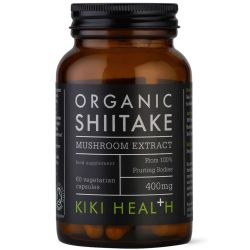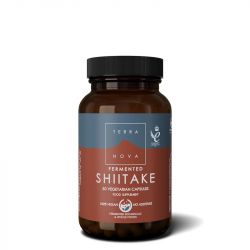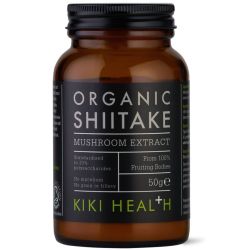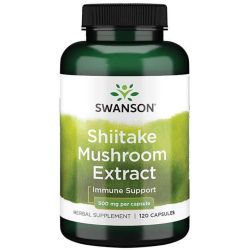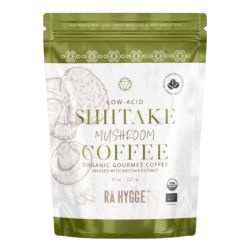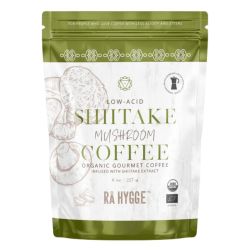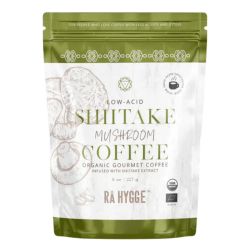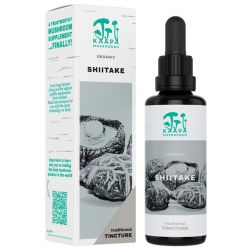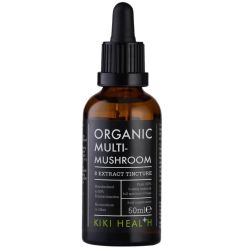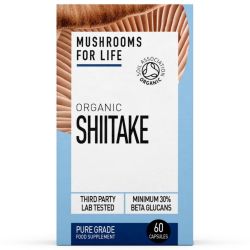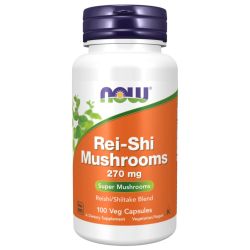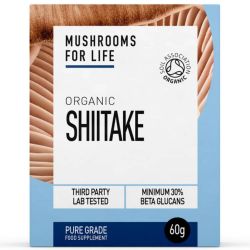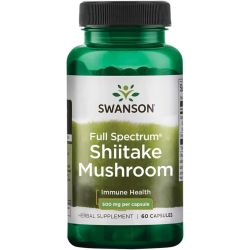Shiitake Mushroom Supplements
Shiitake mushrooms are famous around the world and are used in a huge range of cuisines. They also boast a range of health benefits when taken in a quality supplement form. Browse our range of Shiitake Capsules, Powders and Coffee products.
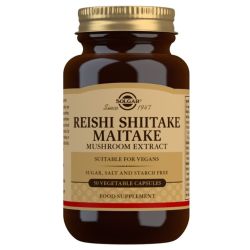 Solgar Reishi Shiitake Maitake Mushroom Extract Vegicaps 50Special Price £25.46 Regular Price £33.95
Solgar Reishi Shiitake Maitake Mushroom Extract Vegicaps 50Special Price £25.46 Regular Price £33.95- Mushrooms for Life Organic Shiitake Capsules 60Special Price £19.99 Regular Price £24.99Out of stock
- Mushrooms for Life Organic Shiitake Powder 60gSpecial Price £25.59 Regular Price £31.99Out of stock
All you need to know about Shiitake
What are Shiitake Mushrooms?
Shiitake mushrooms, scientifically known as Lentinula edodes, are a popular and widely cultivated edible mushroom native to East Asia, particularly Japan, China, and Korea. They are prized for their rich, savory flavor, meaty texture, and numerous potential health benefits. Shiitake mushrooms have been cultivated and consumed for centuries and are now enjoyed worldwide in various cuisines.
What do Shiitake Mushrooms do?
Shiitake mushrooms contain a variety of bioactive substances that contribute to their potential health benefits. These bioactive compounds include:
-
Polysaccharides: Shiitake mushrooms are rich in polysaccharides, particularly beta-glucans. Beta-glucans are complex carbohydrates that have been shown to have immune-stimulating properties. They help modulate the immune system and enhance the body's natural defense mechanisms against infections and diseases.
-
Triterpenes: Shiitake mushrooms contain various triterpenes, including lentinan, ergosterol, and ergothioneine. Triterpenes are bioactive compounds with antioxidant, anti-inflammatory, and potential anticancer properties. Lentinan, in particular, is a polysaccharide with immunomodulatory effects that has been studied for its potential therapeutic use in cancer treatment.
-
Proteins and Amino Acids: Shiitake mushrooms are a good source of protein, containing all essential amino acids necessary for human health. The proteins and amino acids found in Shiitake mushrooms contribute to their nutritional value and support various physiological functions in the body.
-
Vitamins and Minerals: Shiitake mushrooms are rich in vitamins and minerals, including B vitamins (such as niacin, riboflavin, and pantothenic acid), vitamin D (when exposed to sunlight), copper, manganese, and zinc. These nutrients play essential roles in metabolism, immune function, energy production, and overall health and well-being.
-
Antioxidants: Shiitake mushrooms contain various antioxidants, such as selenium, ergothioneine, and phenolic compounds. These antioxidants help neutralize harmful free radicals, reduce oxidative stress, and protect cells from damage caused by reactive oxygen species.
-
Ergothioneine: Shiitake mushrooms are one of the few dietary sources of ergothioneine, a unique antioxidant compound with potential health benefits. Ergothioneine scavenges free radicals, protects cells from oxidative damage, and has been linked to various health-promoting effects, including anti-inflammatory and neuroprotective properties.
-
Other Bioactive Compounds: Shiitake mushrooms also contain other bioactive compounds, such as lectins, nucleotides, and sterols, which may contribute to their potential health benefits. These compounds have been studied for their immunomodulatory, antimicrobial, and cholesterol-lowering effects.
What are the benefits of taking Shiitake Mushrooms?
Here are some of the potential benefits from using Shiitake Mushrooms:
- Immune Support: Shiitake mushrooms contain beta-glucans and other immune-stimulating compounds that may help enhance the body's natural defenses and support immune function.
- Heart Health: Some research suggests that Shiitake mushrooms may help lower cholesterol levels, improve blood lipid profiles, and support cardiovascular health.
- Antioxidant Protection: Shiitake mushrooms are rich in antioxidants, which help neutralize harmful free radicals and protect cells from oxidative damage.
- Anti-Inflammatory Effects: Compounds found in Shiitake mushrooms may possess anti-inflammatory properties, potentially reducing inflammation and related health conditions.
- Support for Blood Sugar Regulation: Shiitake mushrooms may help regulate blood sugar levels and improve insulin sensitivity, making them beneficial for individuals with diabetes or those at risk of developing the condition.
How long does it take Shiitake Mushrooms to work?
The time it takes for Shiitake mushrooms to produce noticeable effects can vary depending on several factors, including the individual's health status, the specific health condition being targeted, the dosage used, and the form in which Shiitake mushrooms are consumed (e.g., fresh, dried, supplement).
-
Type of Benefits:
- Immune Support: Some people may experience a boost in immune function relatively quickly after incorporating Shiitake mushrooms into their diet or supplementation routine. This could manifest as fewer instances of illness or faster recovery times from infections.
- Cholesterol Reduction: If using Shiitake mushrooms to help manage cholesterol levels, it may take several weeks to months to observe significant changes in blood lipid profiles, as dietary interventions typically require time to exert their effects on lipid metabolism.
- Anti-Inflammatory Effects: Compounds found in Shiitake mushrooms may help reduce inflammation over time with consistent use. However, noticeable improvements in inflammatory conditions may take weeks to months to become apparent.
-
Consistency and Dosage:
- Consistently consuming Shiitake mushrooms over an extended period may lead to more pronounced and sustained effects compared to sporadic use. Higher dosages or more concentrated forms of Shiitake mushroom supplements may also yield faster results.
-
Individual Variability:
- Individual responses to Shiitake mushrooms can vary based on factors such as metabolism, genetics, overall health, and the presence of underlying health conditions. Some people may notice improvements sooner than others, while for some, it may take longer to observe any noticeable effects.
-
Form of Consumption:
- Shiitake mushrooms can be consumed in various forms, including fresh, dried, or as supplements. The form in which they are consumed may influence how quickly their beneficial compounds are absorbed and utilised by the body.
When is the best time to take Shiitake Mushrooms?
The best time to take Shiitake mushrooms can depend on various factors, including the intended purpose for use and personal preferences. Here are some considerations to help determine the optimal timing:
-
For Culinary Use:
- Shiitake mushrooms are commonly used in cooking and can be incorporated into a wide range of dishes, including stir-fries, soups, stews, sauces, and more. They can be enjoyed at any mealtime, depending on the recipe and personal preferences.
- Consider adding Shiitake mushrooms to dishes that complement their savory, earthy flavor, such as Asian-inspired stir-fries or hearty soups.
-
For Medicinal Purposes:
- If you're taking Shiitake mushrooms for their potential health benefits, such as immune support or cholesterol reduction, the timing of consumption may depend on the specific health condition being targeted.
- Some people prefer to take Shiitake mushroom supplements with meals to aid digestion and maximize absorption of nutrients. Others may choose to take them between meals or at a separate time of day.
-
For Immune Support:
- Shiitake mushrooms are often taken to support immune function. In this case, consuming them earlier in the day may be beneficial, as it allows the body to take advantage of their immune-boosting properties throughout the day.
- Consider incorporating Shiitake mushrooms into breakfast, lunch, or as a mid-morning or mid-afternoon snack.
-
For Stress Reduction and Relaxation:
- Some people consume Shiitake mushrooms for their potential stress-reducing and relaxing effects. In this case, taking them in the evening or before bedtime may promote relaxation and improve sleep quality for some individuals.
-
Consistency is Key:
- Regardless of the specific timing, consistency is essential for maximizing the potential benefits of Shiitake mushrooms. Aim to include them regularly in your diet or supplementation routine to support long-term health outcomes.
-
Personal Preference:
- Ultimately, the best time to take Shiitake mushrooms depends on your personal preferences, schedule, and lifestyle. Experiment with different timing options to determine what works best for you and fits seamlessly into your daily routine.
What are the side effects of Shiitake Mushrooms?
Shiitake mushrooms are generally considered safe for most people, and they are well tolerated when consumed as a food or supplement.
That said if you experience any kind of common allergic reaction (e.g. Itchy Skin, Rashes) then you should immediately stop using them.
Can I take Shiitake Mushrooms everyday?
How do I grow Shiitake Mushrooms at home?
Here's a basic overview of how to grow Shiitake mushrooms at home using the log cultivation method:
Materials Needed:
- Shiitake Mushroom Spawn: Purchase Shiitake mushroom spawn (also known as "plug spawn" or "inoculated dowels") from a reputable supplier. Spawn is usually made of wooden dowels inoculated with Shiitake mushroom mycelium.
- Hardwood Logs: Select fresh, healthy hardwood logs from trees such as oak, maple, or beech. Logs should be approximately 3-4 feet long and 4-8 inches in diameter.
- Drill with Drill Bit: Use a drill with a drill bit size that matches the diameter of the spawn dowels.
- Wax or Beeswax: Prepare a sealing wax or beeswax to seal the spawn holes and prevent contamination.
- Mallet or Hammer: Use a mallet or hammer to tap the spawn dowels into the drilled holes.
- Storage Area: Choose a shaded, humid area outdoors for incubating the inoculated logs.
Steps to Grow Shiitake Mushrooms:
-
Prepare the Logs:
- Select fresh hardwood logs and cut them to the desired length (3-4 feet).
- Drill holes into the logs at regular intervals (4-6 inches apart) and to a depth of about 1 inch.
- The number of holes will depend on the size of the logs and the amount of spawn available.
-
Inoculate the Logs:
- Insert Shiitake mushroom spawn dowels into the drilled holes. Tap the dowels gently into place using a mallet or hammer.
- Ensure that the spawn dowels are firmly seated in the holes to prevent them from falling out.
-
Seal the Holes:
- Seal each spawn hole with melted wax or beeswax to protect the spawn from contaminants and to maintain moisture levels.
- Apply the wax generously to cover the entire surface of each hole.
-
Incubate the Logs:
- Place the inoculated logs in a shaded, humid area outdoors, such as under a tree or in a covered porch.
- Shiitake mushrooms require a cool, moist environment for colonization. Keep the logs moist by watering them regularly or covering them with a damp cloth.
-
Monitor Growth:
- Shiitake mushroom mycelium will colonize the logs over the next several months to a year, depending on environmental conditions and the quality of the spawn.
- Monitor the logs for signs of colonization, such as white mycelial growth around the spawn holes.
-
Harvest Shiitake Mushrooms:
- Shiitake mushrooms will begin to fruit from the colonized logs when environmental conditions are favorable. This typically occurs after 6 months to 1 year.
- Harvest the mature Shiitake mushrooms by cutting them from the surface of the logs using a sharp knife or scissors.
Additional Tips:
- Environmental Conditions: Shiitake mushrooms prefer cool, shaded environments with high humidity. Monitor moisture levels and provide adequate shade to prevent the logs from drying out.
- Patience is Key: Growing Shiitake mushrooms using the log cultivation method requires patience, as it can take several months to a year for the mushrooms to fruit. Be patient and maintain consistent environmental conditions for best results.

